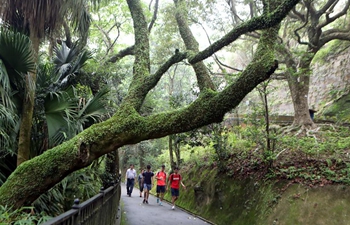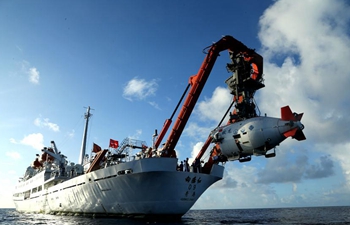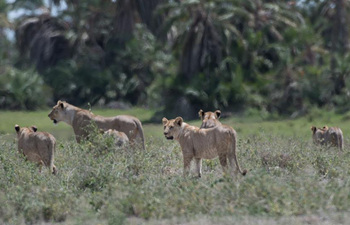ARUSHA, Tanzania, June 1 (Xinhua) -- Lake Manyara hosts many mammals of conservation concern, including the "big five," such as elephant, buffalo, lions, and hundreds of bird species, including flamingos that famously blush the water pink when they gather in numbers.
Located in northern Tanzania, the water body is also home to Lake Manyara National Park, one of smallest and the most diverse park in the east African nation.
It's a lovely scenic park on the road from Arusha to the Ngorongoro Crater, famous for its tree climbing lions, good elephants, and baboons.
Lake Manyara is a shallow lake in the Natron-Manyara-Balangida branch of the East African Rift in Manyara Region.
But in recent years, the water body is facing a serious environmental challenge that threatens its survival due to uncontrolled human activities and climate change, which altogether pose a negative impact on sources of rivers that used to pump water into the water body.
Rivers feeding water into the lake have dried off from 15 to just five, and even these have much of their waters diverted.
Many of the rivers that used to pour water into the lake have dried up; some have become seasonal due to climate change effects, while the remaining five only stream a small fraction of their water into Lake Manyara because of the uncontrolled anthropogenic activities on the upstream of rivers, which pumps fresh water into it.
The ongoing small-scale mining and livestock keeping on the upstream, have a share of blame on this as it increases siltation in the main lake, hence reducing water volume.
Rehema Kaitira, an ecologist with Lake Manyara National Park, describes the sanctuary as one of the UNESCO's Biosphere Reserves, which is under serious threat from uncontrolled human activities.
Water depth of the Lake Manyara, which comprises two-thirds of Manyara National Park, has shrunk 200 times since the 1920s due to anthropogenic factors and climate change which altogether threatens the survival of the park, which came into existence 57 years ago-the second oldest after Serengeti.
The official says rivers flowing into the lake have reduced their discharge because of massive deforestation on the surrounding highlands, whereby many of the 10 rivers previously flowing into the lake have dried up.
Some became seasonal due to effects of climate change while the remaining five only stream a small fraction of their water into Lake Manyara because much of it is channelled to farms. Some of the remaining rivers include Mto wa Mbu, Simba, Kirurumo and Nyoka.
Michael Sungura, who has been growing rice for the past 24 years, says: "Things have changed for the worst, as in the past all rivers that poured fresh water into the lake were full and all had clear water."
Sungura attributed the changes to the high demand of rice for the increased population in Mto wa Mbu Town and neighboring areas, which has also increased the price of rice as one of the factors that have been pushing more people to venture into paddy farming, which in turn, reduces the water that goes into the lake.
He also noted: "This is coupled with the high demand of fresh water for tourists' hotels, guest houses and residents in Mto wa Mbu Township, which lies along the Arusha-Ngorongoro highway."
"As conservators, it is hectic to manage this park due to the overwhelming anthropogenic factors, though we're still working closely with local communities on how best to balance human activities and wildlife survival," says Ibrahim Ninga, officer-in-charge of neighbourhoods with the Lake Manyara National Park.
He said that in the past the lake's depth was at four meters, but now only two meters have remained because of siltation, which during the dry season, forces hippos to move out from where they used to stay further into the lake.
Ninga says the siltation has been caused by human-induced activities outside the park. "We have been informing people around the park that their businesses are booming because of the presence of this park so that they can do something friendly to the environment of the park," he says.
Noelia Miyonga, chief conservator of Lake Manyara National Park says: "We have teamed up with district councils surrounding the park so as to come up with practical measures to save the lake from extinction."
Miyonga also cited limited budget on the side of the district councils as one of the challenges thwarting implementations of the set projects to save the lake.

















